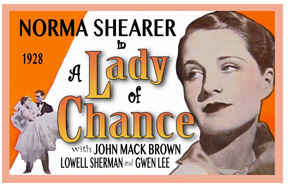

Directed by Robert Z.
Leonard
Produced by Metro-Goldwyn Mayer
Premiere: December 1, 1928
Cast: Norma Shearer (Dolly), Lowell Sherman (Bradley), Gwen Lee
(Gwen), John Mack Brown (Steve Crandall), Eugenie Besserer (Mrs.
Crandall), Buddie Messinger (Hank)
One of Warner Archives' most enjoyable silent DVD offerings is "A Lady of Chance" (1928) starring Norma Shearer, a release that's been around for a few years. However, if you haven't seen it, read on and maybe you'll be convinced you should.
It co-stars Lowell Sherman, Gwen Lee
and John Mack Brown - all who do a superb job - and casts Shearer
as a con artist with Sherman and Lee constantly horning in on
her racket. John Mack Brown is her latest "sucker,"
but about the time she really falls in love with him, Sherman
and Lee show up not believing her "love" story, of 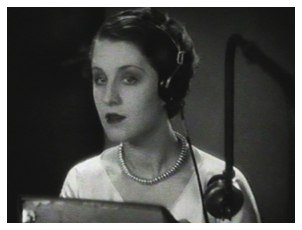 course, and wanting a piece of
the action.
course, and wanting a piece of
the action.
One of the most delightful aspects of the film is that it never takes itself seriously. It doesn't pretend to be even in the same ballpark as films like "Underworld" (1928) or "The Racket" (1928), but, instead, takes a tongue-in-cheek approach to three crooks and how two of them (Sherman and Lee) keep trying to outwit the other (Shearer) and vice-versa.
Having already spent time in prison, Dolly (Shearer) has taken a job as telephone operator at a large hotel where she can take advantage of rich, elderly men. Unfortunately, Bradley (Sherman) and Gwen (Lee) discover their old pal and have their eyes on the same rich guy that Dolly has targeted. So, Dolly is threatened with exposure of her past unless she cooperates with them on the con. What is their "con?" Dolly gets the rich old man up to her place, and Bradley walks in as her husband with threats to ruin the respectable old guy's reputation. Of course, the whole thing can be forgotten for $10,000. Done!
Reconnoitering back at Bradley's place, Brad announces the bad news. The old guy's check was stopped. No money. However, when Bradley and Gwen go into the bedroom and shut the door behind them, Dolly peers through the keyhole. Aha! The two are hiding the $10,000 under a pillow. Later Dolly goes in the bedroom and cries on Gwen's shoulder about how terrible men are - at the same time slipping the cash from under the pillow. When she leaves the apartment, Bradley and Gwen realize the money's gone, and the chase is on!
As noted, this interplay between the rivals provides for a lot of fun in the movie - and some tense moments, as well. None more tense - and funny - than the evening Dolly is to marry Steve and go back to Alabama with him. She met him at a Tile and Cement Convention. Overhearing a conversation, it appears he's rich and owns a big Southern plantation. Unfortunately, she's in the midst of packing after a spur of the moment proposal, and Bradley walks in. He not only wants his money back that she took, but he also wants a piece of the action when she cons Steve out of some cash. For the viewer, it's "Darn it! She almost made it off with this guy. Bradley's like a bad relative always popping up at the wrong time."
For world-wise Dolly, though, no problem.
She tells him they'll work the old racket. Hide in the bedroom.
When Steve arrives, stay there until she coughs and then come
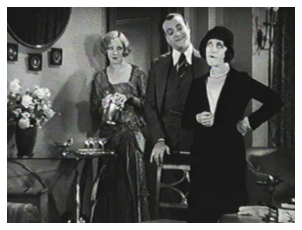 out and hit him with the irate
husband routine. In the bedroom, he listens at the door - he hears
someone come in (it's really the bellhop delivering drinks, but
Bradley doesn't know that). Dolly is talking and then nothing.
After a short while, he hears noises, and then a cough! Bursting
through the door, he finds the maid cleaning the room and Dolly
gone!
out and hit him with the irate
husband routine. In the bedroom, he listens at the door - he hears
someone come in (it's really the bellhop delivering drinks, but
Bradley doesn't know that). Dolly is talking and then nothing.
After a short while, he hears noises, and then a cough! Bursting
through the door, he finds the maid cleaning the room and Dolly
gone!
"A Lady of Chance" is certainly not a story filled with surprises. We know Dolly is going to eventually fall in love with Steve. But it does provide some fun when Dolly arrives in Alabama and finds that Steve lives in a very small, wood frame house with his mother and younger brother. His cement business is totally contained under a shed in his yard, and he and his brother get excited when they get a contract that could net them $40! Oh, brother! All Dolly can think about now is catching that 10:15 train back to the city.
And, of course, the story would not be complete without Bradley and Gwen showing up in Alabama - and there is no way they are going to believe the story about her being in love with this guy. They know she's got to have a con going on - and they're convinced of that when Steve bursts in the door with a telegram. He's been offered $100,000 for his indestructible cement formula!
We won't spoil the rest of the story, but the above description should indicate what a light-hearted and enjoyable 78 minutes of entertainment is in store for the viewer. Sadly, though the reviewers of the time essentially panned the movie. Picture Play said, "Did you ever hear of the spirituelle lady crook who marries the man to trim him and then falls in love and confesses all? She makes her appearance again in 'A Lady of Chance,' and Norma Shearer tries to make her both a noble lady and a hard-boiled comedienne. The result is hardly calculated to quicken one's pulses and evoke audible huzzahs." (1) Variety moaned, "A good example of a picture that can fool many in a projection room. Looking at it cold, it's got nothing but the Shearer name. Little if any entertainment in its dragged-out story of a racket gal redeemed through love of a country youth." (2)
Even the cast wasn't immune to the negatives reviews. Picture Play referred to Shearer's "self-conscious overacting" (3) and Variety was only a bit better noting, "Picture hasn't any action but extracts some spasmodic good moments from Miss Shearer." (4) The usually harsh New York Times was a little kinder. "Considering her luckless part, Miss Shearer does exceedingly well." (5) Regarding Picture Play's assessment that Shearer was "overacting," we'd have to disagree. If this is the case with Shearer, the reviewer would have to say the same thing about stars such as Clara Bow or Colleen Moore - stars whose charm is accentuated by their expressiveness and lively personalities. Again, this is not a serious picture, and Shearer gives the part of Dolly exactly what is needed to put it over. This is also a significant film for Shearer in that it was her last silent. As good as she was in silents (and she brings a special appeal to each of her silent films), she went on to greater fame in the sound era, helped greatly (and not that she wasn't a great actress) because she was being cast in MGM "prestige" pictures such as "The Barretts of Wimpole Street" (1934), "Romeo and Juliet" (1936) and "Marie Antoinette" (1938). She should be more associated with the silent era, though, since 42 of her 62 films credits are silent.
Lowell Sherman never was a leading man
type, but he added so much to so many silent films (remember,
he's the bad guy who tricked Lillian Gish into a fake marriage
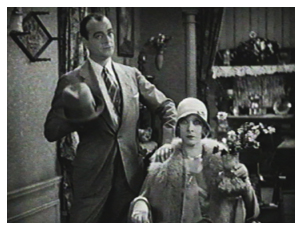 and got her pregnant in "Way
Down East" - 1920) - and, as one would expect, he shines
in "A Lady of Chance." Sherman is perfectly cast as
the suave, sassy, but sometimes bungling con man who tries to
match wits with Dolly. We'll talk about Gwen Lee later, but the
two of them make such a good pair in this film we feel certain
they could have gone on to do a series of pictures as con artists
with a mild comical touch. One of the funniest moments in the
film comes unexpectedly as they arrive at Steve's modest little
shanty down in Alabama. They are waiting for Dolly to come out.
Gwen is seated in a chair beside a small round table with a vase
of flowers on it. Bradley stands beside her holding his hat. Taking
a look around at the quaintly rural surroundings, Gwen takes the
vase of flowers and holds it besides her face with wide, unblinking
eyes staring straight ahead as if posing for a tintype, and Bradley
strikes a pose, erect, with hat held so that it's over the crook
of his arm - almost a comical American Gothic. They hold the pose
for a few seconds, and then it's as if it's time to return to
the movie when Dolly comes in, so they get back to business. So
funny! Sherman appeared in 51 films between 1914 and 1932, but
he also had 15 director credits between 1928 and 1935. Unfortunately,
he died of pneumonia at only 46 years of age in December 1934
(one of his films was released after his death). Of the entire
cast, it seems Sherman garnered the best reviews of any of them.
The New York Times said, "Lowell Sherman's acting
of the unscrupulous Bradley is capital." (6) Variety
offered praise by saying the role of Bradley was "a pushover"
for Sherman's talents. (7)
and got her pregnant in "Way
Down East" - 1920) - and, as one would expect, he shines
in "A Lady of Chance." Sherman is perfectly cast as
the suave, sassy, but sometimes bungling con man who tries to
match wits with Dolly. We'll talk about Gwen Lee later, but the
two of them make such a good pair in this film we feel certain
they could have gone on to do a series of pictures as con artists
with a mild comical touch. One of the funniest moments in the
film comes unexpectedly as they arrive at Steve's modest little
shanty down in Alabama. They are waiting for Dolly to come out.
Gwen is seated in a chair beside a small round table with a vase
of flowers on it. Bradley stands beside her holding his hat. Taking
a look around at the quaintly rural surroundings, Gwen takes the
vase of flowers and holds it besides her face with wide, unblinking
eyes staring straight ahead as if posing for a tintype, and Bradley
strikes a pose, erect, with hat held so that it's over the crook
of his arm - almost a comical American Gothic. They hold the pose
for a few seconds, and then it's as if it's time to return to
the movie when Dolly comes in, so they get back to business. So
funny! Sherman appeared in 51 films between 1914 and 1932, but
he also had 15 director credits between 1928 and 1935. Unfortunately,
he died of pneumonia at only 46 years of age in December 1934
(one of his films was released after his death). Of the entire
cast, it seems Sherman garnered the best reviews of any of them.
The New York Times said, "Lowell Sherman's acting
of the unscrupulous Bradley is capital." (6) Variety
offered praise by saying the role of Bradley was "a pushover"
for Sherman's talents. (7)
Gwen Lee is a highly underrated actress who can be seen today in such silent films as "Laugh, Clown, Laugh" (1928), "Orchids and Ermine" (1927), and two more Norma Shearer vehicles, "Upstage" (1926) and "Lady of the Night" (1925). As a matter of fact, "Lady of the Night" was her first film, but her career didn't end with the talkies. She went on to make a total of 67 films in a 13-year career. "A Lady of Chance" is one of her best vehicles, and she is a welcome addition to this film. Thankfully she is given some choice lines. For example, after she and Brad realize Dolly has made off with the $10,000 they extorted from the old, rich guy, Gwen exclaims with complete seriousness and obliviousness, "I knew that dame was dishonest!" She also does a superb job of pretending to cry (stopping suddenly to make a face at Brad, then just as quickly returning to crying) with Dolly when Dolly is supposedly upset that the rich guy canceled the $10,000 check on them. Lee was a most attractive, willowy blonde who could have easily played romantic leading lady parts. Shame she didn't.
John Mack Brown, as he was known before
his "Johnny" Mack Brown cowboy days in the 1930's and
1940's, does a commendable job. He's portrays the perfect innocence
of an unsophisticated Southern boy who apparently believes in
the goodness of womanhood and also believes everything Dolly says.
Of course, as with all films of this type, the two go into marriage,
and he knows nothing of her family, background or anything - and
the marriage is spontaneous taking place within hours of 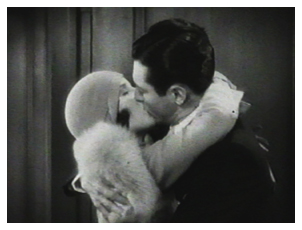 the proposal. Brown's character
is animated, but that's as it should be since he's to portray
the excitement that comes with winning the hand of a woman he
thought to be beyond his grasp and the thrill of getting married.
Although he didn't receive much credit for being a good actor,
he comes through especially well when Dolly tells him she's leaving
- she tells him this is not what she expected, and he will surely
find a nice girl one day. Brown portrays the broken-heartedness
over this announcement without a "hang-dog" look, but
with true sorrow. Unfortunately, MGM always cast him in this innocent,
unsophisticated type of role, but, also fortunately, he found
his niche in sound westerns and became one of the most popular
of the "B" western stars. The reviews of "A Lady
of Chance," not surprisingly, didn't have praise for his
portrayal. Picture Play said simply, "The John Mack
Brown cult certainly does not include me among its votaries."
(8) The New York Times said, "John Mack Brown is acceptable
. . ." (9), and Variety asserted he was not "a
heavyweight on the histrionics." (10)
the proposal. Brown's character
is animated, but that's as it should be since he's to portray
the excitement that comes with winning the hand of a woman he
thought to be beyond his grasp and the thrill of getting married.
Although he didn't receive much credit for being a good actor,
he comes through especially well when Dolly tells him she's leaving
- she tells him this is not what she expected, and he will surely
find a nice girl one day. Brown portrays the broken-heartedness
over this announcement without a "hang-dog" look, but
with true sorrow. Unfortunately, MGM always cast him in this innocent,
unsophisticated type of role, but, also fortunately, he found
his niche in sound westerns and became one of the most popular
of the "B" western stars. The reviews of "A Lady
of Chance," not surprisingly, didn't have praise for his
portrayal. Picture Play said simply, "The John Mack
Brown cult certainly does not include me among its votaries."
(8) The New York Times said, "John Mack Brown is acceptable
. . ." (9), and Variety asserted he was not "a
heavyweight on the histrionics." (10)
There is great title writing for each of the characters. Some examples include: After Dolly has sneaked the $10,000 from under the pillow, she gets up to leave and tells Gwen, "There's no use crying. I always take things as I find them." In another scene, just as Dolly is getting packed so she can go away with Steve, Bradley and Gwen arrive. Out in the hallway, before going into the room, Bradley tells Gwen, "You wait downstairs - this is going to require intelligence." And when Dolly has tricked him once again and escaped with the money, he exclaims to Gwen with utter frustration, "A dame like that ought to be in jail. She's a menace to society."
As we all know, what the critics say is not always an indication of how well a film may do at the box office. Variety, writing their reviews for the exhibitor rather than the fan, always tried to assess a film's potential success for the theatre owners. Admitting that it's not a movie that ranks among the "heavy hitters" of the silent era, we tend to think Variety was right on the money for this one (except the "awful" part). "At least a near capacity matinee audience went for Miss Shearer and her double-meaning pantomime . . . The matinee girls giggled and gurgled. It rolled off the loge section's knife, but the verdict of those Flossies in the cheaper tier is too strong to name this one as a box office cluck. In celluloid rhetoric, it's just that. Rather awful, in fact, and much below other films in which both Robert Leonard, the director, and the star have been concerned. But if the Annies like it here, the chances are that Dubuque's Judie O' Gradys will approve, but don't count on the colonel's lady. So that predicts fair grosses around the country." (9)
Sound films had been the rage since "The Jazz Singer" (1927) appeared, so, obviously, many films from 1928 carried synchronized scores and some even had talking sequences. "A Lady of Chance" had a synchronized score, although the score on the Warner Archives DVD is composed by Christopher Caliendo and performed by Christopher Caliendo's Chamber Jazz Ensemble (July 2001) - and a pleasingly appropriate score it is. Just as the movie has a tongue-in-cheek approach, the music is appropriately sassy, and the jazzy melodies fit the tone of the related sequences to a "T." It would have been nice, however, to also hear the original score that was produced for the film in 1928 - if it exists. The film quality is also excellent - nice, crisp tonality and contrast with just a hint of soft focus. A perfect package for an evening's entertainment!
References
1. "A Lady of Chance" review. Picture Play. April
1929.
2. "A Lady of Chance" review. Variety. January
16, 1929.
3. Picture Play.
4. Variety.
5. "A Lady of Chance" review. The New York Times.
January 14, 1929.
6. Variety.
7. New York Times.
6. Picture Play.
7. New York Times.
8. Variety.
9. Ibid.
Copyright 2015 by
Tim Lussier. All rights reserved